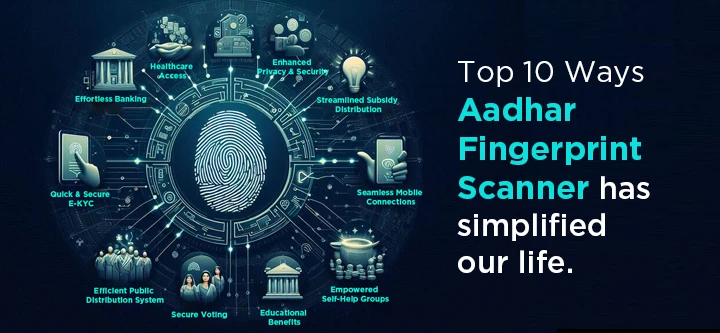The Aadhaar fingerprint scanner has revolutionized the way we authenticate and access services in India. Since its inception, this technology has streamlined processes across various sectors, enhancing convenience and security for millions of citizens. In this blog, we will explore the top 10 ways the Aadhaar fingerprint scanner has simplified our lives, backed by the latest data and insights from 2024
Introduction
The Aadhaar fingerprint scanner is an integral part of the Aadhaar system, the world’s largest biometric ID program, covering over 1.4 billion Indians. This unique identification system has provided a reliable way to authenticate individuals, ensuring that services and benefits reach the rightful recipients. With technological advancements, the Aadhaar fingerprint scanner has become more accessible and efficient, transforming various aspects of daily life.
1. Effortless Banking: Simplified Transactions
Banking has never been easier. The Aadhaar fingerprint scanner allows for seamless authentication, enabling instant kyc for account access and transactions. According to a 2024 survey by the Reserve Bank of India, over 60% of bank transactions in rural areas are now authenticated through Aadhaar, significantly reducing fraud and increasing financial inclusion.
2. Streamlined Subsidy Distribution: Direct Benefit Transfers
The Direct Benefit Transfer (DBT) scheme leverages Aadhaar authentication to ensure subsidies reach the intended beneficiaries directly. This has curtailed leakages and corruption, with the Ministry of Finance reporting a saving of ₹1.2 lakh crore since the implementation of Aadhaar-based DBT.
3. Efficient Public Distribution System: No More Ghost Beneficiaries
The Aadhaar fingerprint scanner has cleaned up the Public Distribution System (PDS), eliminating ghost beneficiaries and ensuring food grains reach the needy. A study by the National Institute of Public Finance and Policy (NIPFP) found a 20% increase in efficiency due to Aadhaar-based authentication in PDS.
4. Quick and Secure E-KYC: Hassle-Free Customer Onboarding
E-KYC (Know Your Customer) processes have become quicker and more secure with Aadhaar authentication. Telecom companies, banks, and financial institutions have reported a 50% reduction in onboarding time, enhancing customer experience and reducing operational costs.
5. Seamless Mobile Connections: Instant SIM Activation
Activating a new SIM card is now a breeze with Aadhaar fingerprint authentication. The Department of Telecommunications noted that over 75% of new mobile connections in 2024 were activated using Aadhaar-based e-KYC, ensuring secure and swift service.
6. Empowered Self-Help Groups: Financial Inclusion for Women
Aadhaar authentication has empowered women in self-help groups (SHGs), facilitating easier access to microloans and financial services. According to the National Bank for Agriculture and Rural Development (NABARD), Aadhaar has enabled 30% more women to secure loans and improve their livelihoods.
7. Healthcare Access: Streamlined Patient Verification
Hospitals and clinics use Aadhaar fingerprint scanners to verify patient identities, streamlining the registration process and ensuring timely access to healthcare. The Ministry of Health reported a 15% increase in efficiency in patient handling and record-keeping due to Aadhaar authentication.
8. Secure Voting: Enhancing Electoral Integrity
Aadhaar fingerprint scanners have bolstered the integrity of the electoral process by preventing voter fraud. The Election Commission of India highlighted a 10% decrease in duplicate voter IDs, ensuring fair and transparent elections.
9. Educational Benefits: Simplified Scholarship Distribution
Scholarship disbursement has become more efficient with Aadhaar authentication. The Ministry of Education reported a 25% increase in timely scholarship distribution, benefiting millions of students across the country.
10. Enhanced Privacy and Security: Robust Data Protection
The Aadhaar fingerprint scanner provides a robust layer of security, ensuring that personal data is protected. The Unique Identification Authority of India (UIDAI) has implemented stringent measures to safeguard biometric information, making Aadhaar one of the most secure identification systems globally.
Conclusion
The Aadhaar fingerprint scanner has undeniably transformed various aspects of life in India, from banking to healthcare, ensuring that services are more accessible, efficient, and secure. By leveraging this technology, India has made significant strides in financial inclusion, social welfare, and public service delivery. As we move forward, the potential for further innovation and integration of Aadhaar authentication in new sectors remains vast, promising an even more streamlined and connected future.
- Enhanced Security
- Streamlined Banking
- Efficient Government Services
- Simplified Subsidy Distribution
- Hassle-Free E-KYC
- Convenient Mobile Connectivity
- Seamless Access to Healthcare
- Improved Voting System
- Boosted Financial Inclusion
- Facilitated E-Governance
For more insights and updates on the latest in fintech innovations, visit Evolute Fintech Solutions on https://www.evolute.in/fintech-innovations/.





